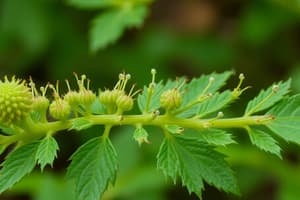Podcast
Questions and Answers
Which branch of botany focuses on the functions and vital processes of plants?
Which branch of botany focuses on the functions and vital processes of plants?
- Plant Taxonomy
- Plant Genetics
- Plant Ecology
- Plant Physiology (correct)
Plant anatomy is concerned with the classification and naming of plants.
Plant anatomy is concerned with the classification and naming of plants.
False (B)
What process do plants use to convert light energy into chemical energy?
What process do plants use to convert light energy into chemical energy?
Photosynthesis
Plants can reproduce _____ through methods such as seeds and flowers.
Plants can reproduce _____ through methods such as seeds and flowers.
Match the following botanical concepts with their definitions:
Match the following botanical concepts with their definitions:
Which of the following is a factor that influences plant growth and development?
Which of the following is a factor that influences plant growth and development?
Plant adaptations can be structural, physiological, or behavioral.
Plant adaptations can be structural, physiological, or behavioral.
What scientific tool is often used to study cellular structures in plants?
What scientific tool is often used to study cellular structures in plants?
Flashcards are hidden until you start studying
Study Notes
Overview of Botany
- Botany is the scientific study of plants, including their structure, properties, and biochemical processes.
- It encompasses various sub-disciplines such as plant physiology, plant ecology, and plant taxonomy.
Major Branches of Botany
-
Plant Physiology
- Studies the functions and vital processes of plants.
- Focuses on processes like photosynthesis, respiration, and nutrient uptake.
-
Plant Ecology
- Examines plant interactions with their environment and other organisms.
- Includes the study of ecosystems, biodiversity, and conservation.
-
Plant Taxonomy
- Involves the classification and naming of plants.
- Utilizes a hierarchical system (kingdom, phylum, class, order, family, genus, species).
-
Plant Anatomy
- Analyzes the internal structure of plants.
- Key components include cells, tissues, and organ systems.
-
Plant Genetics
- Studies heredity and variation in plants.
- Focuses on plant breeding and genetic engineering.
Key Concepts in Botany
-
Photosynthesis
- Process by which plants convert light energy into chemical energy (glucose).
- Occurs primarily in chloroplasts of leaves.
-
Plant Reproduction
- Involves sexual (via seeds and flowers) and asexual (cloning, runners) methods.
- Flower structure includes petals, sepals, stamens, and carpels.
-
Plant Growth and Development
- Influenced by factors like light, water, temperature, and nutrients.
- Growth occurs at meristems (regions of active cell division).
-
Plant Adaptations
- Structural, physiological, and behavioral adaptations allow survival in various environments.
- Examples include drought resistance in succulents and leaf modifications in carnivorous plants.
Importance of Botany
- Essential for agriculture, horticulture, and forestry.
- Plays a crucial role in ecological balance and biodiversity.
- Contributes to medical research and pharmaceutical development through plant-derived compounds.
Tools and Techniques
- Microscopy: Used to study cellular structures.
- Field Studies: Observing plants in natural habitats.
- Genetic Sequencing: Analyzing plant DNA for classification and research.
Current Trends in Botany
- Increasing focus on conservation and sustainable practices.
- Research in plant biotechnology for crop improvement and disease resistance.
- Study of climate change impacts on plant distribution and health.
Overview of Botany
- Botany is the scientific discipline focused on the study of plants, including their anatomy, physiology, and biochemical functions.
- Incorporates various subfields that enhance the understanding of plant life, such as physiology, ecology, and taxonomy.
Major Branches of Botany
-
Plant Physiology
- Investigates the essential functions of plants, including photosynthesis and respiration.
- Studies how plants absorb nutrients and maintain life processes.
-
Plant Ecology
- Explores interactions between plants and their environments, as well as relationships with other organisms.
- Addresses topics like ecosystems, biodiversity, and conservation strategies.
-
Plant Taxonomy
- Focuses on the classification and naming of plants using a systematic hierarchical framework.
- Hierarchical levels include kingdom, phylum, class, order, family, genus, and species.
-
Plant Anatomy
- Examines the internal structures of plants, highlighting components such as cells, tissues, and organ systems.
-
Plant Genetics
- Studies the principles of inheritance and variation in plants.
- Engages in plant breeding and advances in genetic engineering for crop improvement.
Key Concepts in Botany
-
Photosynthesis
- Essential process where plants convert light energy into chemical energy, producing glucose.
- Primarily takes place in the chloroplasts located in plant leaves.
-
Plant Reproduction
- Includes both sexual reproduction (involving seeds and flowers) and asexual methods (like cloning and runners).
- Flower anatomy comprises essential parts such as petals, sepals, stamens, and carpels.
-
Plant Growth and Development
- Influenced by environmental factors such as light, water, temperature, and soil nutrients.
- Growth occurs at meristems, which are active regions where new cells are produced.
-
Plant Adaptations
- Plants develop various structural, physiological, and behavioral traits to survive in diverse environments.
- Examples include succulents adapted to arid conditions and specialized leaves of carnivorous plants.
Importance of Botany
- Critical for advancing agriculture, horticulture, and forestry practices.
- Plays a vital role in maintaining ecological balance and promoting biodiversity.
- Contributes to medical and pharmaceutical research through exploration of plant-derived substances.
Tools and Techniques
-
Microscopy
- Utilized to investigate cellular structures in detail.
-
Field Studies
- Involve direct observation and analysis of plants in their natural habitats.
-
Genetic Sequencing
- Enables the examination of plant DNA for purposes of classification and research advancements.
Current Trends in Botany
- Heightened emphasis on conservation efforts and sustainable agricultural practices.
- Ongoing research into plant biotechnology aimed at enhancing crop yields and disease resistance.
- Investigating the effects of climate change on plant health and geographical distribution.
Studying That Suits You
Use AI to generate personalized quizzes and flashcards to suit your learning preferences.




